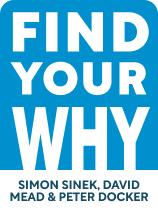

This article is an excerpt from the Shortform book guide to "Find Your Why" by Simon Sinek, David Mead, Peter Docker. Shortform has the world's best summaries and analyses of books you should be reading.
Like this article? Sign up for a free trial here .
How do you write a purpose statement that actually works? What are Simon Sinek’s tips for creating a purpose statement?
A purpose statement is a sentence that declares your Why, or purpose. In the book Find Your Why, Simon Sinek presents a step-by-step process to discover and articulate your purpose, which you can go through with a partner or in a team workshop.
Keep reading to discover Simon Sinek’s purpose statement traits, including an example for starting your own.
Traits of a Purpose Statement
According to Simon Sinek, a purpose statement is a single sentence that declares your ultimate goal and vision.
Sinek says a purpose statement has two parts: The first part should spell out the core action your Why compels you to take. The second part should state what you’re ultimately striving to achieve: the impact you want to have.
An older version of Airbnb’s mission statement is a great example of a purpose statement: To connect millions of people in real life all over the world, through a community marketplace (core action)—so that you can Belong Anywhere (impact). (Shortform note: In First Things First, Stephen Covey also suggests writing a statement of what matters most to you and what you hope to achieve, but he approaches it with more flexibility. While Simon Sinek’s purpose statement succinctly states the core action you take and the key impact you seek in one sentence, Covey’s mission statement more broadly defines your life’s goals and the principles that guide you toward them.)
Sinek says an effective purpose statement has four characteristics.
Characteristic #1: Short and User-Friendly
According to Simon Sinek, a purpose statement should be easy to understand and clear about how you’ll put it into action. By keeping it short, you help yourself remember your Why and keep it in mind when you take action. Additionally, Sinek argues that keeping it at one sentence helps ensure that it’s truthful because it forces you to state only what matters most.
Characteristic #2: Impact-Focused
For the second part of a purpose statement, Simon Sinek instructs you to focus on the impact of your work and your positive effect on others. Sinek stresses that having a positive impact feeds our sense of fulfillment because fulfillment comes from serving others rather than seeking our own satisfaction.
Like many people, you may disagree with this idea, thinking that your purpose at work is surface-level. However, if you think the fulfillment that comes from earning a lot of money is your only reason to pursue work, Sinek believes you should dig deeper: The underlying reasons likely benefit others. For instance, you might be as fulfilled working at a mission-driven startup as you’d be working for a profit-driven corporation, as long as you’re making a lot of money. But before declaring that your Why is to make money, Sinek advises you to follow the process outlined in the following chapters. Dig deeper and see what that money represents. Is it to build a strong foundation for future generations? Is it so your family can live life to the fullest? There’s something else that money will unlock—that’s your Why.
(Shortform note: If you’re struggling to see how your purpose benefits others while supporting your own interests, ask yourself a question Joshua Fields Millburn and Ryan Nicodemus pose in Minimalism: “How am I adding value to the lives of others?”)
Characteristic #3: Meaningful and Declarative
According to Simon Sinek, a purpose statement should inspire you or your team to reach within for your best version, as you already are. This is a meaningful, truthful version of yourself, not an aspirational—or worse, doctored—version.
Many branding strategies rely on aspirational or perfected versions of their mission to appeal to customers, investors, and employers, but Sinek warns against this strategy. He argues that it’s a detectable form of manipulation that makes people stop trusting you once they figure out who you really are. Additionally, relying on a false purpose to promote yourself means you’re wasting the opportunity to find your true purpose, and with it, fulfillment and sustainable success.
However, once you’ve identified your true purpose, Sinek encourages you to incorporate it into your marketing and branding. If your purpose is sincere, people will connect with it. (Shortform note: Other specialists agree that you must approach mission-driven branding with honesty, earning consumers’ trust through your business model, in addition to broadcasting your purpose through marketing.)
Characteristic #4: Constant
Your purpose is a constant in all aspects of your life and work. Sinek notes that your desired effect doesn’t change over time or in different situations. But while you have only one purpose statement, you’ll find different ways to express your purpose in different contexts. For instance, if your purpose is to help people create meaningful connections, as a manager you will build rapport with your employees and nurture a vibrant culture in your team, and as a friend you will find opportunities to introduce acquaintances to each other when you notice they share common interests.
| Alternative Approach to Simon Sinek’s Purpose Statement In First Things First, Stephen Covey recommends gaining clarity on your purpose by writing what he calls a mission statement. He outlines the characteristics of an effective mission statement, some of which are similar to Sinek’s suggestions. But Covey’s flexible and holistic approach to the mission statement considers other characteristics that Sinek doesn’t: – While Sinek believes you need a brief statement that doesn’t embellish your purpose, Covey is more flexible and encourages creative self-expression. – Covey suggests that your personal mission statement address your four basic human needs: survival, connection, learning, and giving back. Given Sinek’s focus on impact, he would argue that a purpose statement should mostly be about giving back. – Covey is more specific than Sinek in emphasizing that your mission statement defines the universal principles you will apply to achieve your purpose. – According to Simon Sinek, a purpose statement is a constant in your life, but Covey gives more guidance on how to make the mission statement relevant to all the spheres of your life by ensuring it includes all the different roles you play. |
Example: A Personal Purpose Statement
This example of a personal purpose statement shows how each characteristic contributes to the effectiveness of the overall statement: “To help women unleash their inner power to create a life in which they feel fulfilled, inspired, and empowered.”
1. It’s a single sentence, so it’s easy to remember and use to make decisions.
2. It’s clearly focused on the impact the person seeks to have.
3. It’s meaningful and it declares real goals and actions so the writer can easily know which opportunities or ideas are aligned with her purpose, or Why.4. However, it’s not so specific that it limits her to only one type of work. It would be a constant whether she’s at work, in civic or volunteer work, and even in her interactions with friends and family. She could be a life coach for women, a venture capitalist who seeks out women-led ventures—or, a mother or friend with a knack for empowering girls and women.

———End of Preview———
Like what you just read? Read the rest of the world's best book summary and analysis of Simon Sinek, David Mead, Peter Docker's "Find Your Why" at Shortform .
Here's what you'll find in our full Find Your Why summary :
- Simon Sinek’s steps to understanding and living your purpose and your organization’s
- How to create and write your purpose statement
- What to do after you find your Why: Determine your How






